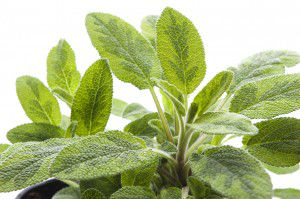
Sage, an aromatic herb native to the Mediterranean regions of Europe and Asia Minor, has been used for thousands of years medicinally. Egyptian women would drink sage tea for fertility and Hippocrates himself prescribed it for healing. The ancient Chinese valued the herb so much that they were willing to trade four times the weight of their tea for sage.
The genus name for sage, salvia, is derived from the Latin salvere, which means to heal or save, and to be healthy.
Sage has extremely potent antioxidant and antibacterial properties and is thought to have begun as a preservative, when it moved from the medicine cabinet to the kitchen. Early recipes used it in sausage or with meat, as it helps break down fats in food.
Sage is an easy-to-grow herb that is an attractive addition to any home or kitchen garden. Its early summer flowers are beautiful, and it comes in a variety of colors. Sage provides an abundant harvest and holds its flavor well when dried. The leathery leaves are grayish-green in color, and the fragrance varies from a balsam odor to a lavender or even fruity fragrance.
5 tips for growing sage
Provide sun – Sage is a sun-loving plant. Make sure the location you select receives at least 6 hours of sun a day for best plant growth.
Plant in well drained soil – In addition to good sunlight, the area you select should also have excellent drainage to prevent root rot. Sage is particularly fond of rocky slopes.
Harvest – Let the plant grow for the first year without harvesting. This will allow the plant to establish a better harvest the next year. After the first year, however, it is best to harvest annually.
Pruning – It is a good idea to prune twice a year after harvesting to keep the plant from becoming too busy or weedy. Be sure to use garden clippers that are sharp and clean for this job.
Try growing sage in containers – If you have run out of room in your garden, try growing sage in a pot. This plant can even be grown inside near a bright window. Just remember, potted plants require more water than those placed directly in the ground.
9 things to do with sage
Season meat: Sage goes great wrapped around some sausage, crushed onto chicken, topping a turkey sandwich, or sauteed with beef tips.
Top fruit: The spicy flavor of sage pairs wonderfully with fruit to offset the sweetness. Try with apple, pineapple or mango.
Add to soup and sauces: Adding whole sage leaves to soups and sauces makes for a great flavor boost.
Make tea and cold drinks: Dried sage leaves can be brewed as a tea for sore throat relief. Freeze ice cubes with sage leaves to freshen up cold tea or lemonade. Mix into a smoothie for extra flavor.
 Use as a bug repellent: Crushed sage leaves rubbed on your skin repels insects. When camping, burn some dried sage to keep the bugs away or mix in a bottle with white vinegar for an effective topical bug spray.
Use as a bug repellent: Crushed sage leaves rubbed on your skin repels insects. When camping, burn some dried sage to keep the bugs away or mix in a bottle with white vinegar for an effective topical bug spray.
Remove unpleasant odors: If you have offensive odors such as fish or cigarette smoke lingering around, burn some sage in a dish to freshen the air.
Make soap: Sage soap and lotion are soothing and fragrant. Mix some with your already-made soaps and lotions, or try making some homemade versions.
Landscape: Sage is a beautiful herb and has attractive blooms. This gorgeous plant looks lovely when used as a border.
Make shampoo: Mix sage with a little ivory liquid soap to make shampoo. Sage will leave your hair soft, shiny and smelling great.
-The Alternative Daily

